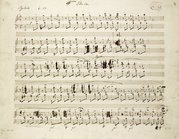



A - Autograph
| Date: | ⇒II 1837 |
| Title: | 4me Etude |
| Dedication: | None |
A includes numerous deletions and corrections, so generally it could be described as a working one. Despite this fact, it undoubtedly served as the base text for FE, which is proved by visible, numerous engraver notes. It is the only preserved manuscript from the set intended for FE, including the entire Op. 25. Moreover, it is most probably the only Stichvorlage manuscript of this Etude.
The deletions and corrections reveal Chopin's detailed work on refining the harmonic details (cf., e.g., bar 27), clarifying the articulation and phrasing in the R.H., marking the dynamics and pedalling. It is the labour-consuming remake of notation, not having a direct influence on the sound of music, that draws attention – e.g., replacing quaver stems with beams or staccato signs with a verbal indication (cf., bars 9-11). The range and number of these corrections, probably introduced in haste, favoured distraction leading to inaccuracies of varied size – cf., bars 15, 15-16, 25-26 and 38.
The significant number of deletions could have had an influence on omission of a number of changes introduced in FC and base text to EE in A – Chopin had an impression that A was already well-developed and he subconsciously avoided an excessive number of corrections and additions. It is also possible that he instinctively feared that the manuscript could become illegible. This category can include, e.g., changes in bar 16, pedalling in bars 25-26, 46, 58-61, change of E to C in bar 60 and perhaps also the dynamic indications in bars 1-12 and 39-53. We indicate this assumption, in spite of the fact that in each type of this situation one could easily give another explanation, as for example a common oversight resulting from the creative work on refining details and optimising the notation overlapping with editorial activities consisting in parallely ordering and unifying the notation of three Stichvorlage manuscripts.
Despite numerous corrections, the slurring of the Etude was not marked precisely by Chopin, which became a reason of doubts of copyists and engravers (and then editors) – cf., bars 17-19, 27, 48, 55-57.
A (→FE) also includes certain elements, probably added in the last moment, which are absent in the remaining sources, e.g., a  in bar 8, the last pedal in bar 57, and particularly a grace note in bar 63. However, it is the metronome tempo that has the biggest influence on the character and sound shape of the Etude, which in A (→FE) is clearly slower than in the remaining sources.
in bar 8, the last pedal in bar 57, and particularly a grace note in bar 63. However, it is the metronome tempo that has the biggest influence on the character and sound shape of the Etude, which in A (→FE) is clearly slower than in the remaining sources.
| Original in: | Bibliothèque Nationale de France, Paris |
| Shelf-mark: | Rés. 50 (2) |

